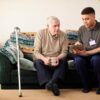Nursing is a profession grounded in science, with each decision and care strategy stemming from a deep understanding of the human body and its functions. When you step into the world of nursing, you must understand how scientific knowledge intertwines with patient care. There are a number of different scientific domains, and everything from anatomy and physiology to epidemiology is important to learn about.
Anatomy and physiology
Anatomy and physiology are cornerstones of nursing practice. They provide the framework for understanding how the body functions in health and disease. As a nurse, when you assess patients, you are examining their anatomical structures and observing physiological processes. The interplay between these two aspects is critical. For example, when measuring blood pressure, you need to know where to place the cuff (anatomy) and understand what the readings signify about heart function (physiology).
Homeostasis is a key related concept. It is the body’s ability to maintain stable internal conditions. Disruptions in homeostasis can lead to illness or make existing conditions worse. It is why vital signs like temperature and electrolyte balance are regularly monitored. Nurses are relied upon to detect early signs of imbalance and intervene appropriately.
How a disease presents itself can vary due to anatomical differences among people. This variation means that a tailored approach is needed for effective treatment. Recognizing that one-size-fits-all solutions do not apply in healthcare is fundamental for personalized nursing care.
Pharmacology
The next scientific foundation that’s important for nurses to understand is pharmacology. The reason this is so important is that it allows nurses to administer medications safely. Principles like pharmacokinetics and pharmacodynamics need to be understood in terms of knowing how drugs move through the body and how that affects a patient’s physiological processes. Nurses will be taught about the concept of ADME (absorption, distribution, metabolism, and excretion) to predict drug responses and ensure the right dose is being used.
Recognizing how drugs interact is a big part of patient safety. Nurses must stay informed about how different drugs may cause harm or minimize therapeutic effects when they’re combined together. On a similar note, knowing about contraindications can help prevent prescribing or administering medication that could be dangerous under certain conditions. A common example of this is not prescribing certain medications to women when they’re pregnant.
Genetics can change how an individual person responds to medicine, too. It largely comes down to metabolism, as genetic variations can alter drug metabolism rates. This topic is especially important when it comes to personalized medicine.
Microbiology
Microbiology is the next scientific concept that needs to be understood. As a nurse, you need to understand how bacteria, viruses, fungi, and parasites interact with the body to cause illness. This knowledge allows you to recognize and anticipate potential infections.
Infection control practices are equally important. You are on the front lines of preventing hospital-acquired infections, and these can be life-threatening. Focus on adhering to strict hand hygiene protocols, using personal protective equipment correctly, and ensuring that all medical instruments are sterilized.
Something that has made this area more complex is the emergence of antimicrobial resistance. It is where microorganisms evolve into new strains, and the treatments we use no longer work as well or at all. It means it’s even more important to strictly follow guidelines when administering antibiotics and educate patients about doing the same at home.
Another exciting area where microbiology intersects with nursing care involves our understanding of microbiota. These are the trillions of beneficial microbes living on and inside our bodies. Research increasingly shows that these organisms are extremely important in maintaining health and influencing how we respond to treatment.
Pathophysiology
In the same way that physiology is about the processes of the body, pathophysiology is about how diseases affect these processes and the body. The benefit of knowing about this area of science is that you’ll know what to look out for. For example, if you know that inflammation can lead to symptoms like redness or swelling, you’ll know how to anticipate patient needs in advance. Both inflammation and immune response are at the heart of many conditions nurses encounter daily. These biological processes are frequently found in acute illnesses like infections, as well as chronic diseases.
Two good examples here are diabetes and heart disease. These chronic conditions have complex pathophysiologies that involve multiple organ systems. In diabetes, issues with insulin production or function lead to elevated blood sugar levels. It affects everything, from vision to wound healing. Heart disease might involve narrowed arteries that reduce blood flow, and this could strain the heart muscle over time. By knowing all of this in advance, nurses can both detect things earlier and know what types of interventions are required.
How much you want to be involved with these different scientific foundations can dictate what type of nurse you become, too. A question a lot of nurses ask is, “Should I get my MSN or DNP?” In the context of pathophysiology, an MSN program will deepen your understanding of diseases and their physiological impacts. It is important for advanced clinical roles. On the other hand, a DNP focuses more on applying this knowledge to implement and evaluate healthcare practices at a systemic level. At schools like the University of Indianapolis, they have options for both types of degrees, and their courses are extremely flexible. You just need to decide what interests you the most, and thinking about each of these scientific foundations can help you make that choice.
Nutrition
Next up is nutrition. It is an area that perhaps hasn’t received as much focus from the medical world as it should have, but there are still some good basics to understand for nurses. The first area where it becomes important is in terms of patient recovery and health maintenance. Good nutrition supports the body’s repair processes, boosts immunity, and provides the energy required for daily activities. Nurses can assess a patient’s nutritional needs based on their age, health status, and specific medical conditions.
Nutritional assessment involves evaluating dietary intake, understanding lab results that reflect nutritional status, and recognizing signs of malnutrition or nutrient deficiencies. Nurses must be well-trained to identify these indicators. They can then intervene when they need to with things like diet modifications or supplementation.
Your intervention strategies can be significantly important in the realm of chronic disease, both in terms of management and prevention. For example, a diet low in saturated fats and high in fiber can help manage cardiovascular diseases, and there are tailored diets that make diabetes much easier to control.
Psychology
Nurses don’t need to be experts in psychology, but they do need to have an understanding of it. The needs of patients are complex, and they aren’t just physical. There are emotional and mental health needs that need to be taken into account. Maslow’s Hierarchy of Needs is a good starting point. It can help you identify the most pressing needs a patient has and where your attention should be focused first.
Assessing a patient’s mental health is something else that may be part of their care. As a nurse, you will need to recognize signs of psychological distress or disorders in the patients you work with. It could be done through simple discussions about feelings and behaviors, as well as more thorough assessments. Nurses contribute significantly to the development of comprehensive treatment plans.
The influence of psychological factors on patient compliance is very important. Beliefs about illness, fear, anxiety, and depression can all impact whether patients will follow their treatment plans. A nurse’s empathetic communication skills are very important here. The more you can build trust and understanding with your patients, the more you increase their likelihood of following through with prescribed treatments.
Epidemiology
At its core, epidemiology involves studying how diseases spread and affect populations. This knowledge allows you to identify patterns and risk factors associated with different illnesses. You can then use that information to guide prevention and control strategies. Nurses engage with the principles of epidemiology regularly.
The main way they do this is through disease surveillance. Nurses are often the first to recognize unusual symptoms or clusters of illnesses that may signal an outbreak. By documenting these observations and reporting them through the proper channels, you contribute data that helps track the progression of the disease. This data is then used by public health professionals to decide on the next steps.
This isn’t just about lots of patients getting sick all of a sudden, either. Epidemiology is relevant in a lot of different ways. If you understand the local rates of hypertension, it can prompt more rigorous blood pressure monitoring for patients in affected areas. It’s just one example, but there are many, many others.
The findings from this type of research don’t just sit on shelves in storage rooms. They actively shape public health policies. These policies can affect everything from vaccination schedules to screening protocols and so on. In extreme cases, as we have seen in the last few years, they can impact all areas of society.
Medical terminology
Medical terminology simply refers to the language used in health care. By adopting this language, communication can be both clear and concise. It’s especially important when sharing information with other healthcare professionals. As a nurse, you will frequently need to document patient information. Understanding what terminology you need to use is extremely important.
Given that medical jargon is constantly growing, it may seem daunting to keep on top of it all, but it doesn’t need to be. Reading medical journals, attending workshops, and just generally following the world of medicine are all good methods to keep pace with new developments. Your coworkers and mentors can help here, too.
When you’re dealing with patients, the way you interact with medical terminology changes. Here, it’s important to break it down and simplify the terms for patients. Intricate medical concepts can be difficult to understand for healthcare professionals at times, let alone patients with very little exposure to them. It’s for this reason that translating these terms into everyday language is so important. It is how patients become empowered and are able to make informed decisions.
Beyond documentation, this type of terminology is important to use when working in multidisciplinary teams. Healthcare moves quickly, and everybody on the team needs to understand exactly what’s going on. Using common terminology ensures that all team members, from physicians to support staff, work cohesively towards the same goal.
Nursing theories and models
When research is conducted in any field, evidence is found, and it is then used to create models for how to do certain things. Sometimes there are theories that were thought up long before modern research existed, and due to their effectiveness, they are still widely used today. In nursing, there are many examples of both of these.
One good example of a major nursing theory is Florence Nightingale’s Environmental Theory, which emphasizes the importance of a patient’s surroundings in their healing. Another is Virginia Henderson’s Need Theory, which focuses on assisting patients with independence. Another is Jean Watson’s Theory of Human Caring, which places caring at the center of practice. Each theory brings different and unique perspectives on patient care.
The practical applications of these theories are vast. For example, Nightingale’s work encourages nurses to manipulate a patient’s environment while they recover. It includes lighting as well as cleanliness, and so on. Henderson’s model may lead a nurse to focus more on helping patients perform daily activities post-surgery to regain their autonomy quickly.
Diverse theoretical frameworks serve different purposes. Some models prioritize holistic care, and others might be more task-oriented or relationship-based. When comparing these models in patient care scenarios, it becomes clear that some align better with certain populations or healthcare environments than others.
The scientific foundations of nursing touch every aspect of patient care. Each of these areas and more will continue to grow as well. Nurses do not need to be able to teach a class on each of these topics, but they do need to understand them. Doing so will make them extremely effective at their job and ensure they have a long and successful career.







